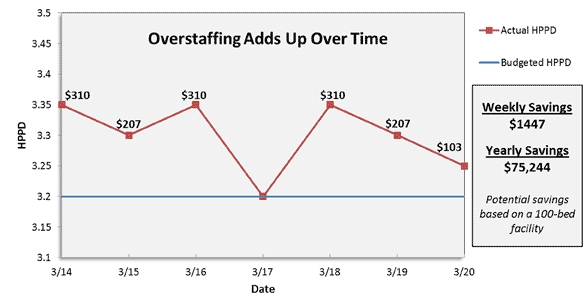Significant reimbursement cuts, regulatory reform, and an uncertain economy are forcing long term care providers to make the most of every dollar that they possibly can. Controlling labor costs—a provider’s largest operating expense—is a critical priority, now more than ever before. Instead of reducing staff, smart executives are driving efficiencies and cutting unnecessary costs in order to thrive during these challenging times.
One of the most effective ways to squeeze costs without reducing head count is right-sizing staff.
This means that facility or community management makes sure that they have the right number of people, in the right place, at the right time, all the time. Right-sizing staff day in and day out delivers the savings and efficiencies that can get a long term care organization running at top speed, at the right cost, while maintaining the high-quality care residents deserve.
Overstaffing is much more common than one might think. Overstaffing in long term care organizations happens on a daily basis, but often the administrators and executive directors do not believe they are overstaffed. That’s because overstaffing commonly occurs just a little bit at a time—one shift here, one shift there—and it is very hard to see if the provider is using a paper schedule.
Many providers overstaff on purpose, in preparation for call-offs, but then rarely cancel shifts if the call-offs do not occur.

While it may seem like nickels and dimes, overstaffing adds up very quickly (see right). Even a minor variance in a provider’s labor budget versus actuals can be significant. For example, if a 100-bed facility is running at 0.1 HPPD (hours per patient day) over budget among direct care staff, reducing it can save approximately $75,000 annually.
Step By Step
Explore the following steps to identify overstaffing and how to staff appropriately to avoid it in the future. The odds are high that overstaffing is driving up costs in a big way.
Get transparency into staffing levels by understanding supply (staff) and demand (census) in each and every building and location. For skilled nursing providers, HPPD is a good method for identifying staffing levels. For assisted living providers, determine the level of service residents want or need, and roll this up to a summary of required labor hours.
Next, use these measures to compare staffing actuals with a targeted labor budget for each department and position. Identify areas where hours were greater than the target by reviewing historical payroll data by day for a 30-day time frame. Nurses are expensive resources. If the majority of overstaffing is happening with nursing staff, it could be costing significant unnecessary expense.
Consider acuity among residents when making this determination. A larger number of high-acuity cases may have driven the need for higher staffing levels. Hitting staffing targets is important, but not at the expense of care.
Study The Odds
Providers need to identify how they became overstaffed. Pull past schedules and see how much overstaffing was built into the schedules at the start of a scheduling period. Review staffing levels at each shift. What patterns can be identified? Is overstaffing common during particular shifts or days of the week?
With schedules in hand, dig into the processes surrounding scheduling. What census level is the organization staffing to on a regular basis, and how does it correlate to reality? Many providers have experienced a decrease in census in the past several years yet continue to staff at maximum levels.
How does the scheduler respond when there is a change in census? It’s common for providers to schedule staff based on a natural census, but oftentimes they do not adjust as the census fluctuates. This alone can lead to additional employees who are not necessarily required.
Providers increase their chances for success by viewing staffing as a proactive practice and preparing for change at each and every shift. Proper scheduling is key to running a right-sized organization.
Modify processes so that schedulers use an estimated future census in order to plan for the right number of staff, with the right qualifications, to stay on target.
Check Over Established Time Period
Evaluate staffing plans based on a week or pay period, and make decisions based on a projected census and acuity or service levels for that time period. Consider any overstaffing patterns that were identified, and avoid those when building out schedules.
In addition, review the process for filling call-offs. It’s common for schedulers to “plug the hole” left by a call-off, but in looking at the current census, that shift may not have needed to be filled. Establish guidelines that require the census to be reviewed whenever a call-off or unplanned open shift occurs.
One of the most important practices to right-sizing an organization is to remain active and involved. Staffing is dynamic and requires day-in and day-out management. Establish a policy that requires staffing levels to be reviewed at the start of each and every shift.
Incorporate a review of the daily and future staffing plan in daily meetings. Review the resident census throughout the course of the day, and make adjustments to scheduled staff based on these requirements. If resident releases are expected in the next shift or day, this presents an opportunity to reduce staff without sacrificing care or resident satisfaction.
What’s great about a right-sized staffing strategy is that it can go beyond nursing into additional departments. Efficiencies and savings can grow significantly through proper staffing across departments.
One provider company unknowingly found itself overstaffed by 0.24 HPPD across multiple facilities. This variance represented $3 million in excess costs in one year alone.
Mark Woodka is chief executive officer of OnShift, a provider of Web-based staff scheduling and shift management software. He can be reached at mwoodka@onshift.com.